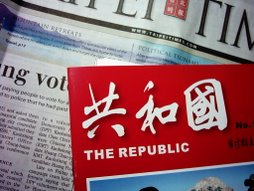
--------------------------------------------------------------------------------
Published on Taipei Times
http://www.taipeitimes.com/News/editorials/archives/2007/03/12/2003351975
Picking and chosing the history we want to keep
By Ku Ting-wei 古庭維
Monday, Mar 12, 2007, Page 8
`Such cherry picking of historical sites is reason for disappointment and resentment.'
The proposal to change the name of Chiang Kai-shek Memorial Hall and the demolition of its outer walls have caused much controversy. The Taipei City Government has attempted to list the memorial hall, which was completed in 1980, as an official historical site. But it has forgotten to preserve the city's historic railways, which were completed more than a century ago in 1893.
As children, we learned from our textbooks such things as the shape of the Republic of China (ROC) is somewhat similar to that of a begonia leaf. Meanwhile, we ignored things that were not covered in the textbooks, such as the 228 Incident. Nor were we taught about the railway construction launched by Taiwan's first governor, Liu Ming-Chuan (劉銘傳), between Keelung and Hsinchu, which came into operation later in 1893. In the book, The 100th Anniversary of Taiwan Railway, there is even a photo of the Keelung Station built by Liu.
But growing up, we realize that the shape of the ROC was more like an old hen, and we began to learn about the massacre that began on Feb. 28, 1947. Moreover, those who study railway history learn that due to the poor quality of Liu's railways, the whole system was abandoned long ago, with only a few historical relics remaining.
In late 2004, during a historical site review, it was determined that the roof of the Taiwan Railway Administration's (TRA) old auditorium might possibly be the frame of the Taipei Station built by Liu. Since relics of the old line are extremely rare, the finding was surely precious. However, faced with pressure to build a new MRT station at the site, it was decided that the auditorium had to be removed during construction of the underground station, then returned to its original location later.
The location of a historical site is of great significance, and they should not be moved arbitrarily. The auditorium built during the Qing dynasty, had withstood Japanese colonization and the post World War II era, as it morphed from a station into a railway workshop and finally an auditorium. It witnessed the rise and fall of the three regimes, and symbolizes the beginnings of Taiwan's industrialization. However, due to the perfunctory decision made by Taipei's Department of Cultural Affairs, it was moved.
Soon after the relocation work started, workers discovered a railway base of the original line about 60cm below the floor. The reappearance of the base was as stunning as that of the "terracotta army" excavated in China, and the scene was magnificent. The problem was, it would be even more difficult to relocate the base. Finally, the department fell in line with the government's call for "desinicization" by removing the Chinese site and demolishing the entire base.
Ever since the historical site was revealed, the department has taken a passive attitude toward it. Despite the cultural value of the site, which contains important historical remains from the Qing dynasty, it has received little attention.
In comparison to the outer walls of the memorial hall, such cherry picking of historical sites is reason for disappointment and resentment.
Ku Ting-wei is a student in the Graduate Institute of Microbiology and Biochemistry at National Taiwan University.
Translated by Eddy Chang
Copyright © 1999-2007 The Taipei Times. All rights reserved.

No comments:
Post a Comment